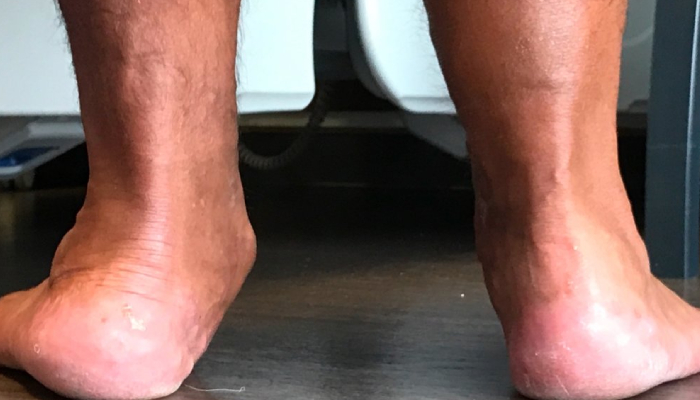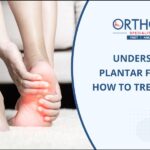
Flat foot reconstruction surgery is carried out to relieve pain and restore function in people whose foot arches are very low and where orthotics have not helped. Problems may be caused by a deformity, damage to the tendon that supports the arch or arthritis in the joints around the heel.
What does it involve?
The procedure is usually done under a general anaesthetic with an injection in the foot to numb it and reduce pain after the operation. In most cases you will stay overnight in hospital.
During surgery, three incisions (cuts) are made in the foot and the painful, damaged tendon on the instep is removed and replaced with another tendon (the flexor digorum longus tendon or FDL). This is known as tibialis posterior tendon reconstruction.
A procedure known as calcaneal osteotomy is usually carried out at the same time; this involves making a cut in the heel bone so that it can be repositioned and fixed with a metal screw. Repositioning the heel bone helps improve support to the foot arch. The surgeon may also place a metal plate at the top of the foot to increase the arch. You will be able to discuss these procedures with your specialist beforehand.
Complications
Complication rates for flatfoot reconstruction are low. However, the procedure carries the risks of any surgery, including infection, bleeding, blood clots, nerve or blood vessel damage, and anesthesia-related problems. Other complications include a failure of the bones or the surgical wound to completely heal.
Sometimes, a patient may be bothered by the hardware left in the foot to stabilize the bones. If this occurs, it is usually possible to remove the hardware after healing is complete.
Types of flatfoot reconstruction
Nonsurgical treatment
In many cases, flatfoot can be corrected by nonsurgical treatment, especially when detected early. Types of nonsurgical flatfoot treatment include:
- Rest and immobilization—Decreasing or completely stopping any activities that aggravate the arch of the foot can help the healing process tremendously. Total bed rest is sometimes required to allow the correction of flatfoot.
- Ice therapy—Placing an ice pack on the foot and ankle for 20 minutes at a time can alleviate pain, swelling and inflammation.
- Anti-inflammatory medication—Aspirin, ibuprofen and naproxen are common over-the-counter anti-inflammatory medications used to control pain and inflammation.
- Orthotic inserts—An insole can be added to your shoe for arch support.
- Orthopedic footwear—A leg brace or orthopedic shoe may be recommended by your doctor to reduce pressure and impact on the affected foot. Protecting your foot and ankle from further use can allow the arch and surrounding ligaments to heal properly.
- Cortisone injections—Cortisone is a steroidal medication that can be injected directly into the tissue in the arch to reduce swelling, inflammation and pain.
- Physical therapy—A physical therapist can show you new techniques and ways to perform activities than can reduce impact on and damage to the foot and ankle. Physical therapy is often combined with one or more of the other nonsurgical treatments.
Surgical treatment
Posterior tibial tendon dysfunction
Posterior tibial tendon dysfunction is a condition in which the tendon connecting the calf muscle to the inner foot is torn or inflamed. Consequently, the damaged tendon can no longer serve its main function of supporting the arch of the foot. Flatfoot is the main result of this type of condition and can be treated by the following flatfoot reconstruction surgeries:
- Lengthening of the Achilles tendon—Otherwise known as gastrocnemius recession, this procedure is used to lengthen the calf muscles. This surgery treats flatfoot and prevents it from returning. This procedure is often combined with other surgeries to correct posterior tibial tendon dysfunction.
- Cleaning the tendon—Also known as tenosynovectomy, this procedure is used in the earlier and less severe stages of posterior tibial tendon dysfunction. It is performed before the arch collapses and while the tendon is only mildly affected. The inflamed tissue is cleaned away and removed from the remaining healthy tendon.
- Tendon transfer—This procedure is done to correct flatfoot and reform the lost arch in the foot. During the procedure, the diseased tendon is removed and replaced by tendon from another area of the foot. If the tendon is only partially damaged, the inflamed part is cleaned and removed, then attached to a new tendon.
- Cutting and shifting bones—Also called an osteotomy, this procedure consists of cutting and reconstructing bones in the foot to rebuild the arch. The heel bone and the midfoot are the most likely to be reshaped to achieve this desired result. A bone graft may be used to fuse the bones or to lengthen the outside of the foot. Temporary instrumentation such as screws and plates may also be used to hold the bones together while they heal.
Treatments
Book Appointment
Book Your Appointment Today
We welcome your questions Do you have questions regarding your own situation? Do you actually want to resolve your problem and not just temporarily cover up the pain?




